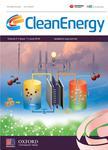版权所有:内蒙古大学图书馆 技术提供:维普资讯• 智图
内蒙古自治区呼和浩特市赛罕区大学西街235号 邮编: 010021

作者机构:Master Program of Mechanical EngineeringFaculty of Mechanical and Aerospace EngineeringInstitut Teknologi BandungBandungIndonesia Faculty of Mechanical and Aerospace EngineeringInstitut Teknologi BandungBandungIndonesia Research Center for New and Renewable EnergyInstitut Teknologi BandungBandungIndonesia
出 版 物:《Clean Energy》 (清洁能源(英文))
年 卷 期:2023年第7卷第2期
页 面:313-327页
核心收录:
学科分类:083002[工学-环境工程] 0830[工学-环境科学与工程(可授工学、理学、农学学位)] 08[工学]
基 金:supported by Research and Community Service Program(P2MI)ITB
主 题:CO_(2)emissions cement industry carbon capture calcium looping calcination carbonation
摘 要:Carbon dioxide(CO_(2))is the main contributor to greenhouse gases that affect global *** industrial sector is the third largest producer of CO_(2) and the cement industry is one of the industries that consistently produces the most significant CO_(2) *** cement industry produces 5-8% of global CO_(2) *** methods for reducing specific CO_(2) emissions have been reported in the cement industry,including calcium looping,which uses the reversible reaction between calcination[calcium carbonate(CaCO_(3))decomposition]and carbonation[CO_(2) capture by calcium oxide(CaO)].This work investigates calcium looping employing limestone obtained directly from several cement factories in Indonesia to observe the carbon-absorption characteristics of limestone from different mining *** experiment was carried out using a tube furnace equipped with a controlled atmospheric condition that functions as a calciner and a carbonator.X-ray diffraction and scanning electron microscopy with energy-dispersive x-ray spec-troscopy characterization were conducted to analyse the changes in the experimental *** results demonstrated that the reactor configuration was capable of performing the calcination process,which converted CaCO_(3) to calcium hydroxide[Ca(OH)_(2)],as well as the carbonation process,which captured carbon and converted it back to CaCO_(3).Parametric analysis was performed on both reactions,including pressure,temperature,duration,particle size and reaction *** results show that the limestone obtained from all sites can be used as the sorbents for the calcium-looping process with an average reactivity of 59.01%.Limestone from cement plants in various parts of Indonesia has the potential to be used as carbon sorbents in calcium-looping *** a similar CO_(2) concentration as the flue gas of 16.67%,the experimental results show that Bayah limestone has the maximum reactivity,as shown by the highest carbon-content a